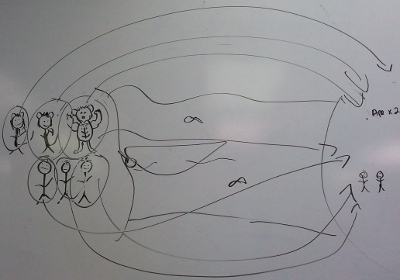
After the apparent frustration among my students yesterday, I decided to try an easier problem. I started my first class with this one:
A farmer wants to get his cow, tiger, and lettuce to the other side of a river. His boat can only carry him and either his cow, tiger, or lettuce. But ...
- if he leaves the cow alone with the lettuce, the cow will eat the lettuce
- if he leaves the tiger alone with the cow, the tiger will eat the cow
When the farmer is present, the cow and lettuce are safe. How does the farmer manage to get everything safely across the river?
You may recognize this problem but with a different animal and vegetable. I chose to modify it so students would have less luck with googling for the solution 😃.
Most of the groups solved this pretty quickly (within 10 minutes). The ones that struggled were drawing a state (where each object was), then erasing it to go to the next state, rather than showing a progression of states. Perhaps that was one cause of their difficulty.
Once a few groups had solved this, I put up the next problem:
Three men, two orangutans, and a gorilla have to cross a stream. There is only one boat and it can only carry two of the six characters. Each of the men and the gorilla can paddle the boat by themselves (with or without a passenger). The problem is that if at ANY TIME there are more apes than humans in one place the apes will beat the humans to death. How do you do it?
I also told them that I had attempted it over the weekend but was unable to solve it 😃.
There were two main methods for attacking this problem: descriptive and pictorial.
Here's a representative attempt using words:

And here's a representative attempt using pictures. Note how each change in state modifies the diagram, so no history of state changes is evident.

At this point I showed the entire class a method for recording each state change in a vertical diagram. After 5 or 10 more minutes students were disengaging. However one group (mostly one member) persisted until the end of class. Here is the first part of their solution--I've cropped it because they were actually successful in solving it. (Yay!)

When the majority of the class had disengaged (and before the one group above solved the gorilla problem), I put up the next problem:
Consider the diagram below.
How many upright triangles are there?
This problem produced amazing engagement. You could feel a noticeable increase of energy in the room. Not only that, but there was spontaneous sharing between groups. At one point there were 5 or 6 students at the Smartboard telling each other how to count all the triangles, however by the end of the class there was still no correct answer.
My second class had a similar progression to the first, but there was virtually no interest in the gorilla problem. Students made it clear that they just weren't going to work on it. Perhaps because it was the 2nd last block of a Friday. When I put up the triangle problem, there was significant engagement and again a group of students arguing at the Smartboard.
Although there was a lot of engagement, the counting methods didn't appear to be overly systematic. So I decided to draw a diagram with 1 row, then 2 rows, then 3 rows, and finally 4 rows. I suggested that starting with easier versions of the problem would help them be more systematic in their approaches. After 5 or 10 minutes, the large group at the Smartboard were able to come up with a correct answer.
Conclusions
Stay tuned. As I mention in a reply to an earlier comment, soon I will be using an upsidedown lesson (see my Culture of Thinking Post), leveraging questions from the MathWorks 12 workbook.